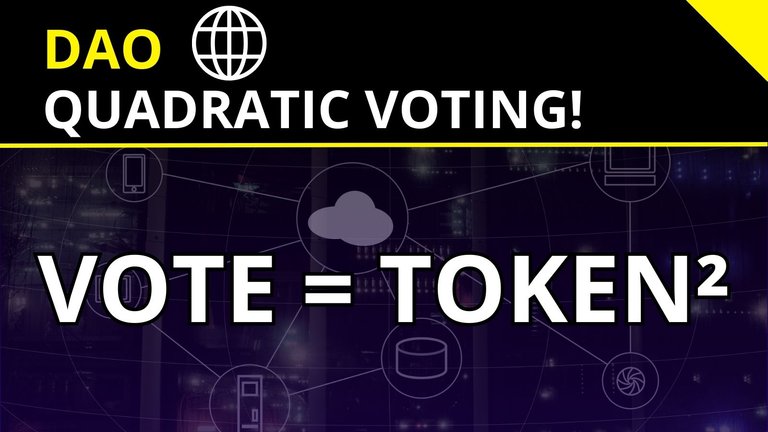
Many questions arise when it comes to decentralizing a project, and the most important thing is to define what the voting system for proposals and changes within the DAO will be. We often see the number of tokens being counted as the number of votes, that is, a 1:1 ratio of token to vote. However, this very common method guarantees excessive power for holders of very large amounts of tokens, making small holders have no relevance whatsoever. Thus, the quadratic voting system emerges to solve this type of problem, ensuring a better distribution of votes. Come and find out more about this voting system and its implementation difficulties.
I'll be much appreaciated if you Upvote, Reblogs or give any Tips ( PIZZA 🍕, PGM 🎮, LOLZ 😆, ALIVE ❤️, etc ). Thanks and have good reading! 🍀

[ENGLISH VERSION]
Quadratic Voting System

The Quadratic Voting system makes the amount of Stake required be the square of the number of votes it represents, that is, it would be a formula of the following type: Stake Cost = (Number of Votes)², following the example in the table above. This system means that in order for a person to have an additional vote, they need to square the number of votes in tokens, making the weight of small holders greater, but maintaining a greater weight in the votes for those with a high stake, since they would still have more weight in the votes, but in a smaller proportion than in a 1:1 system.

This voting system aims to prevent a user with a high amount of Tokens from being able to dominate any proposal that is being voted on in a DAO, since in systems that work on the ratio 1 Token in Stake or Liquid = 1 Vote, it causes a minority at the top, which holds the majority of the Supply of tokens, to be able to decide the future of the project, removing any participation from users with less voting power. Furthermore, the problem becomes worse if this small group ends up having very similar ideas and agreeing with each other, without any of them disagreeing with the path being taken. The problem is that the minority or any holder who ends up diverging from the top holders would end up being seen as an opponent as well. Thus, this new voting system through quadratic voting aims to provide greater equality among participants while maintaining relevance and the benefits of having a high HBR Stake in voting, since the largest holders will still have greater weight. However, as no system is perfect, this one also has a flaw, which is its vulnerability to sybil attacks. ---
Challenges of the Quadratic Voting System

The problem with this quadratic voting system for DAO is that it is susceptible to a Sybil Attack. This attack occurs when someone creates multiple accounts with a minimum Stake of 1 Token to have the highest cost-benefit in relation to Token Stake x Votes, dominating the votes with the lowest possible cost, since they divided their Stake between multiple accounts and increased their voting power since they got the best Token:Vote ratio. With this in mind, there are several forms of protection, but one that seems simple to implement and that can keep the system safe is the Economic Cost, stipulating a minimum amount of tokens for the vote to start being valid. This defense is intended to make it difficult to stake tokens in several accounts at the same time, since the user would have to buy a huge amount of tokens to distribute this minimum amount among several accounts, which generally makes the operation unfeasible.
The idea is that it should be a value that is not difficult for an active user of the project to reach, but that is at the same time difficult for many accounts to reach easily. This balance is difficult to achieve and perhaps the solution would be a formula that adapts the minimum amount of tokens as the number of users increases or according to the supply of tokens, to prevent the amount from becoming too easy to obtain. The idea is that it should not be an easy amount to obtain, but also not impossible to prevent this type of attack. In addition, there are several other forms of defense that can be used in conjunction with this Economic Cost to make this system more secure.


Muitas dúvidas surgem quando o assunto é a descentralização de um projeto, sendo que o mais importante é definir qual será o sistema de votação de propostas e mudanças dentro da DAO. Muitas vezes vemos ser contabilizado a quantidade de tokens, como a quantidade de votos, ou seja, uma relação de 1:1 de token para voto, entretanto essa forma bem comum garante um poder excessivo para os detentores de quantidades muito grandes de tokens, fazendo com que os pequenos holders não tenham relevância nenhuma. Assim, surge o sistema de votação quadrático buscando resolver esse tipo de problema, garantindo uma melhor distribuição de votos. Venha descobrir mais sobre esse sistema de votação e as suas dificuldades de implementação.
Fico agradecido se você puder dar um Upvote, Reblogs ou algum Tips ( PIZZA 🍕, PGM 🎮, LOLZ 😆, ALIVE ❤️, etc ). Obrigado e boa leitura! 🍀

[VERSÃO PORTUGUÊS]
Sistema de Voto Quadrático

O sistema de Votação Quadrático faz com que a quantidade de Stake necessária seja o quadrado do número de votos que ela representa, ou seja, seria uma fórmula do seguinte tipo: Custo de Stake = (Número de Votos)², seguindo o exemplo da tabela acima. Esse sistema faz com que para a pessoa ter um voto a mais ela precise do quadrado do número de votos em tokens, fazendo com que o peso dos pequenos holders seja maior, mas mantendo um peso maior nos votos para quem tem um alto stake, já que ela ainda teria mais peso nos votos, só que numa proporção menor do que em um sistema 1:1.

Esse sitema de votação visa evitar com que um usuário com alta quantidade de Tokens seja capaz de dominar qualquer proposta que estiver sendo votado em uma DAO, já que em sistemas que funcionam na proporção 1 Token em Stake ou Líquido = 1 Voto, faz com que uma minoria no topo, que detém a maior parte do Supply de tokens, seja capaz de decidir o futuro do projeto, retirando qualquer participação de usuário com menor poder de voto. Ainda, o problema se agrava se esse pequeno grupo acabar tendo ideia muito parecidas e concordarem entre si, sem que haja um deles que venha discordar do caminho que está sendo tomado, o problema é que a minoria ou algum holder que acabar divergindo dos holders do topo acabaria sendo visto como um contrário também. Assim, esse novo sistema de votação através de um voto quadrático, visa proporcionar uma maior igualdade entre os participantes mantendo a relevância e ainda os benefícios de ter um alto Stake de HBR nas votações, já que os maiores holders ainda terão um peso maior. Entretanto, como nenhum sistema é perfeito, esse também tem um defeito que é a sua vulnerabilidade à ataques sybil.
Desafios do Sistema de Voto Quadrático

O problema com esse sistema de votação quadrático para DAO é que ele é passível de receber um Ataque Sybil. Esse ataque ocorre com alguém criando múltiplas contas com o Stake mínimo de 1 Token para ter o maior custo benefício em relação à Stake de Tokens x Votos, dominando as votações com o menor custo possível, já que dividiu o seu Stake entre múltiplas contas e aumentou o seu poder de voto já que pegou a melhor relação de Token:Voto. Pensando nisso, existem diversas formas de proteção, mas uma que parece ser simples de implementar e que consegue manter o sistema seguro é o Custo Econômico, estipulando um valor mínimo de tokens para o voto começar a valer. Essa defesa vem para dificultar o Stake de Tokens em várias contas ao mesmo tempo, já que o usuário teria que comprar uma quantidade gigante de Tokens para distribuir esse mínimo entre diversas contas, o que geralmente torna inviável a operação.
A ideia é que seja um valor que não seja difícil para um usuário ativo do projeto atingir, mas que seja ao mesmo tempo difícil de ser alcançado por muitas contas de forma fácil. Esse equilíbrio é dificil de conseguir e talvez a solução seja uma fórmula que vá adaptando a quantidade mínima de Tokens a medida que o número de usuários aumente ou de acordo com o Supply de Tokens, para evitar que a quantidade se torne fácil demais para ser obtida. A ideia é que não seja uma quantidade simples de conseguir, mas também não seja impossível para evitar que haja esse tipo de ataque. Além disso, existem diversas outras formas de defesa que podem ser usadas em conjunto com essa de Custo Econômico para deixar esse sistema mais seguro.


If you like Crypto, Play2Earn, Finance or Anime content, consider FOLLOW me, that way you'll receive a notification when new post is done.
Thank you for reading. See ya! 👋👋
Posted Using INLEO
